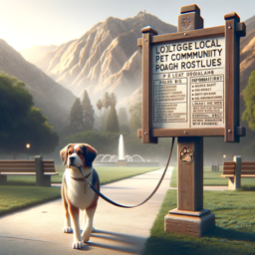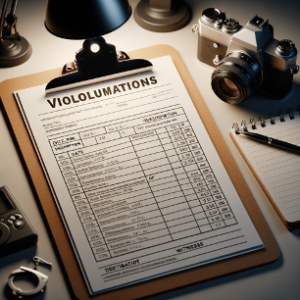What to Do When Your Neighbor’s Pet Breaks Local Ordinances
Understanding Local Ordinances: A Comprehensive Guide to Pet Regulations
As a pet owner, understanding your local ordinances is crucial not just for compliance, but for the well-being of your furry friends and the harmony of your community. Local pet ordinances, which often include leash laws, noise regulations, and pet waste management rules, serve an essential purpose in fostering a safe and enjoyable environment for everyone.
In this blog post, we will delve into these common local ordinances, why they are important, and how adhering to them contributes to a peaceful community.
Why Are Local Pet Ordinances Important?
Local ordinances are designed to maintain order and promote good relationships among community members. In terms of pet ownership, these laws address specific concerns and issues that arise when pets and people coexist. Here are some key reasons why animal control ordinances are vital:
- Safety: Laws regarding leashes and containment ensure that pets do not pose a danger to themselves or others, including other pets and wildlife.
- Responsibility: Pet waste management regulations encourage owners to clean up after their pets, preventing public health hazards and keeping community spaces clean.
- Community Harmony: Noise ordinances help to minimize disturbances caused by barking dogs or other pet-related noises, ensuring that neighborhoods remain peaceful.
When pet owners are informed and compliant with local ordinances, it enriches community life for everyone.
Common Local Pet Ordinances You Should Know
1. Leash Laws
Leash laws dictate that pets must be kept on a leash when in public spaces. This ordinance serves multiple purposes:
- Control: Leashes help prevent dogs from running into traffic or approaching other people or animals uninvited.
- Violation Consequences: Many areas impose fines for violating leash laws, creating a financial incentive for owners to follow the rules.
- Variation by Location: Not all places enforce leash laws equally; for instance, some parks might allow dogs off-leash if they’re under voice control, while others may not.
Tip: Always check local regulations before heading out with your pet to avoid surprises.
2. Noise Regulations
Barking dogs can be a significant nuisance for neighbors. Local ordinances addressing noise often specify allowable noise levels and times when pets can be vocal. This might include:
- Time Restrictions: Certain areas may have defined “quiet hours” when noise (like barking) should be minimized.
- Reported Complaints: If frequent complaints are reported, local authorities may step in with fines or warnings.
- Barking Limitations: Some municipalities may enforce limits on how long a dog can bark within a certain timeframe.
Example: If your dog tends to bark excessively, consider training or behavioral interventions to mitigate this issue. Not only will it keep the peace with your neighbors, but it’ll also enhance your dog’s overall quality of life.
3. Pet Waste Management
Cleaning up after pets is critical for both sanitation and community aesthetics. Many localities have strict ordinances in place to regulate pet waste. Key points include:
- Mandatory Cleanup: Most cities require pet owners to clean up waste immediately and carry bags to do so.
- Fines for Violation: Failing to clean up can result in fines, which may be steep depending on the city or municipality.
- Public Surfaces: Some rules specifically address waste in public parks and residential areas, making it clear where and when it must be cleaned up.
Actionable Tip: Keep biodegradable waste bags handy when walking your dog. Not only is it good for the environment, but it demonstrates responsible pet ownership.
How to Stay Informed About Local Ordinances
Navigating the sometimes complex world of local pet ordinances can feel overwhelming. Here are some practical tips to ensure you’re up-to-date:
- Local Government Websites: Most municipalities have comprehensive resources available online detailing local pet laws.
- Community Forums: Engage with local pet owner groups through social media or community forums where discussions about ordinances often take place.
- Speak with Neighbors: Conversations with fellow pet owners can offer insights into practical application and experiences with local laws.
Question: Have you had any challenges or misunderstandings related to local pet ordinances? Share your story in the comments!
Conclusion: The Importance of Compliance
Understanding and complying with local pet ordinances is not just about following the law—it’s about being a responsible pet owner and a good neighbor. By adhering to leash laws, noise regulations, and proper waste management, you contribute to a safer, cleaner, and more harmonious community.
As a responsible pet owner, it’s essential to educate yourself and others about these regulations. Share this information with fellow pet lovers to promote awareness in your community.

Why Open Communication Matters
Open communication ensures that misunderstandings are cleared up and grievances are addressed before they escalate. By approaching your neighbor with respect and an open mind, you lay the groundwork for a dialogue that benefits both parties. Communicating effectively fosters goodwill and community spirit, which are critical in creating harmonious living environments.
Tips for Initiating the Conversation
- Choose the Right Moment
- Timing is crucial when starting a conversation about pet-related issues. Approach your neighbor when they appear relaxed and not preoccupied with other tasks. A walk around the neighborhood or a casual chat in the yard can be great opportunities.
- Start with a Friendly Greeting
- Begin the conversation with a warm hello. A friendly demeanor can diffuse tension and make the other party more receptive to the discussion.
- Example: “Hi, I hope you’re having a great day! I wanted to talk to you about something that came up regarding our pets.”
- Focus on “I” Statements
- Using “I” statements brings the discussion to a personal level, making it less likely to put your neighbor on the defensive. Instead of saying, “Your dog barks too much,” try, “I’ve noticed that my dog gets anxious when he hears barking, especially at night.”
- This approach emphasizes your feelings and experiences rather than placing blame.
- Be Specific and Offer Solutions
- Instead of general complaints, provide specific examples of behaviors that are problematic and suggest possible solutions. This not only shows your concern but also your willingness to find a resolution.
- Tip: “Perhaps we could work together on some training techniques? I know a few resources that might help improve the situation for both our pets.”
- Listen Actively
- An open dialogue requires both parties to speak and listen. Allow your neighbor to express their feelings and thoughts. This will make them feel valued and understood, paving the way for effective problem-solving.
- Remember, they may have insights or solutions that you hadn’t considered.
Practicing Respect and Understanding
While approaching your neighbor, keep in mind that maintaining respect is fundamental. Here are some additional tactics to foster understanding:
- Stay Calm: Emotions can easily escalate; keep your tone friendly and calm.
- Avoid Accusations: Phrase your concerns in a way that doesn’t come across as an attack. For example, rephrase “You never clean up after your dog” to “I sometimes find waste in our shared area, which can be concerning for everyone.”
Follow-Up for Continued Harmony
After your initial conversation, follow up with your neighbor to ensure the discussed solutions are being implemented. A simple text or quick chat can reinforce a sense of community and collaborative care for your shared environment.
- Check In: A week or so after your conversation, touch base with your neighbor. “Hey, how’s everything going? Have you noticed any changes?” Asking for feedback shows that you genuinely care about your neighbor’s perspective and are invested in the relationship.
Conclusion: The Importance of Positive Neighborhood Relationships
Addressing issues concerning your pet requires an open mind and a friendly approach to communication. Taking the time to discuss concerns respectfully can strengthen your relationships and create a more pleasant living experience for everyone.
By opening lines of communication, you not only tackle issues promptly but also position yourself as a considerate neighbor. Together, let’s continue fostering a sense of community that promotes respect and understanding.

Documenting Violations: A Necessary Step Toward Responsible Pet Ownership
When navigating local pet ordinances, it’s just as important to know what to do if those rules are violated as it is to understand them in the first place. Whether it’s an off-leash incident in a leash-required area, consistent noise disturbances, or failure to clean up after a pet, documentation is key to addressing these issues effectively. Keeping a thorough record of violations not only helps protect your rights as a pet owner but also aids in promoting a harmonious community environment.
Why Documentation is Vital
Recording incidents of violations can play a crucial role in resolving disputes, as well as ensuring compliance with local ordinances. The significance of documentation can be summarized as follows:
- Evidence Building: Having a concrete record can serve as evidence if disputes escalate or if you need to report a recurring issue to authorities.
- Accountability: Documented incidents help hold pet owners accountable for their actions, encouraging responsible behavior and adherence to local regulations.
- Pattern Recognition: By keeping track of repeated incidents, you can better identify patterns that may indicate ongoing problems needing attention from local authorities or community groups.
How to Document Violations Effectively
To create an effective record of any violations, follow this structured approach:
- Date and Time: Always note the exact date and time of the incident. This data will help establish a timeline, which is crucial for illustrating the frequency or patterns of violations.
- Detailed Descriptions: Write clear and concise descriptions of each incident. Include key information such as:
- Type of Violation: Specify whether it was a leash law violation, noise complaint, etc.
- Location: Record where the violation occurred (e.g., local park, street).
- Description of the Event: Detail what occurred during the incident, including any interactions with other pets, owners, or bystanders.
- Photographic Evidence: If possible, take photos of the incident. This could include:
- Images of the pet off-leash in a restricted area.
- Pictures of piles of pet waste that haven’t been cleaned up.
- Visuals showcasing the noise disruption (e.g., a video of excessive barking).
- Witness Statements: If others witnessed the incident, ask for their accounts. Documenting their names and contact information can help provide additional credibility to your case.
- Logs or Spreadsheets: Keep all this information organized in a log or spreadsheet. You can create a simple template with columns for date, time, violation type, location, description, and witness details.
Real-World Example: A Case of Persistent Violations
Imagine a scenario where you frequently encounter a neighbor’s dog running loose in a leash-required area, causing disturbances. By following the documentation methods outlined above, you might note the following:
- Date: March 15, 2023
- Time: 3:30 PM
- Violation Type: Leash Law Violation
- Location: Community park on 5th Avenue
- Description: The neighbor’s golden retriever was off-leash, approached other dogs aggressively, and barked incessantly, causing them to react nervously.
- Photo Evidence: Attached images show the dog loose during the incident.
- Witness Statement: John Smith, a fellow pet owner, observed the incident and is willing to provide his identification if needed.
Over time, if you notice this happening repeatedly, you can compile all logs for a comprehensive report should further action be necessary.
When to Take Further Action
If documentation shows a persistent disregard for local pet ordinances, you may need to escalate your concerns. Consider the following steps:
- Contact Authorities: Share your records and detailed descriptions with animal control or local law enforcement. This documentation will strengthen your case.
- Community Meetings: Attend local community meetings to discuss the issues openly. By doing so, you can raise awareness and encourage the establishment of community standards for pet ownership.
- Neighborhood Agreements: Sometimes, creating a neighborhood pet agreement can help lay down clear expectations and responsibilities among pet owners.
Conclusion: The Importance of Vigilance
Maintaining records of local ordinance violations is an essential practice for pet owners who want to uphold community standards and responsibilities. Thorough documentation empowers you to address issues constructively, promoting an environment of accountability and cooperation.

Offer Solutions to Common Pet Issues
Understanding the importance of local pet ordinances is a significant first step for responsible pet ownership, but there are often challenges that arise when integrating pets into neighborhoods. From barking dogs to roaming pets, various issues can create tension between pet owners and neighbors. The good news is that there are practical solutions that can foster a cooperative atmosphere and mitigate these challenges.
1. Encourage Attendance in Pet Training Classes
One of the most effective ways to address behavioral issues in pets is through training. Encouraging your neighbor to enroll their dog in training classes can lead to significant benefits. Here’s how:
- Professional Guidance: Certified trainers can provide tailored advice and techniques to help modify unwanted behaviors, like excessive barking or jumping on visitors.
- Socialization: Training classes often include opportunities for dogs to interact with each other, promoting healthy social behaviors and reducing anxiety.
- Community Building: Joining pet training classes can help neighbors connect with one another, fostering a sense of camaraderie among local pet owners.
Tip: If you’re comfortable, you might offer to attend the training classes together. This can create a supportive environment for both you and your neighbor.
2. Suggest Creating Physical Barriers
For pets prone to roaming or causing disturbances, installing physical barriers can be an effective solution. Here are some options to consider:
- Fences: A well-maintained fence can keep pets secure in their yard while preventing them from wandering into neighbors’ properties.
- Pet Gates: For those living in multi-level homes or open areas, pet gates can help restrict access to certain areas where noise or roaming could be an issue.
- Landscaping Solutions: Low shrubs or decorative planters can create natural boundaries that deter pets from entering specific areas of the yard.
3. Share Resources for Noise Mitigation
If a dog’s barking is causing unrest, suggesting noise mitigation strategies can be invaluable. Some practical resources and techniques include:
- Soundproofing: Encourage your neighbor to consider soundproofing measures in their home, such as heavy curtains or acoustic panels that can help absorb sound.
- Calming Techniques: Recommend products like anti-bark collars or calming aids (like pheromone diffusers) that can help reduce excessive barking.
- Routine Establishment: Encourage them to establish a routine that includes designated times for walks and play. Keeping pets engaged and exercised can lead to reduced barking and noise.
4. Organize Community Pet Playdates
Creating more opportunities for pets to socialize can also dramatically reduce behavioral issues. Organizing community playdates can provide a platform for pets to interact positively, easing territorial instincts and noise complaints. Here’s how to make this happen:
- Host a Local Gathering: Propose setting up regular meetups at local parks. Encourage all dog owners in the neighborhood to participate, allowing pets to become accustomed to each other and reducing the likelihood of disputes.
- Group Activities: Engage in activities like group training sessions, agility courses, or pet-friendly events, fostering a sense of community while keeping pets active and engaged.
5. Offer to Help with Waste Management Solutions
Pet waste can be a significant cause of conflict between neighbors. Here are solutions to address this concern constructively:
- Waste Stations: Suggest the installation of community waste stations equipped with bags and disposal bins in local parks or shared areas.
- Personal Reminders: If you feel comfortable, offer friendly reminders to neighbors when their pets have left waste. This can be done with a light-hearted approach to avoid defensiveness.
- Group Clean-Up Days: Organize community clean-up days, where pet owners come together to clean local parks and shared spaces. This fosters community pride and encourages collective responsibility.
Conclusion
By approaching issues collaboratively and proactively, neighbors can create an environment that prioritizes both pet and community well-being. Implementing these solutions can not only reduce potential conflicts but also enhance the overall harmony of your neighborhood.

Know Your Rights: Legal Avenues and Procedures for Addressing Animal Control Issues
If you find yourself facing challenges related to pet regulations in your community, understanding your legal rights and the available avenues for resolution is crucial. Knowing how to navigate animal control laws and procedures not only empowers you as a resident but also fosters a more cooperative and respectful community.
Legal Protections for Pet Owners
As a pet owner, you have specific rights and protections under local, state, and even federal laws. Familiarizing yourself with these rights can help you advocate for yourself and your pets. Here are key legal protections that may apply:
- Right to Ownership: Most laws protect the rights of pet owners to have pets as long as they comply with local ordinances.
- Animal Welfare Act: This federal law sets minimum standards for the care and treatment of animals, which can apply if you believe an animal is being neglected or abused in your community.
- Anti-Discrimination Laws: In some cases, pet owners may be protected against discrimination based on the breed or type of animal they own. It’s essential to check for local regulations prohibiting breed-specific legislation.
Understanding Local Animal Control Laws
Local animal control laws can vary significantly by municipality but are critical for ensuring community safety and welfare. Here’s how to familiarize yourself with these regulations:
- Research Local Laws: Municipal websites often provide essential information on animal control laws. Make sure to check the specific ordinances that apply to your area, including the regulations on licensing, leash laws, and pet noise ordinances.
- Connect with Local Animal Control Authorities: Reach out to your local animal control office for clarification on ordinances. They can provide guidance on specific laws, enforcement procedures, and how to properly report violations or concerns.
- Review State Laws: State laws may offer additional protections and frameworks for animal welfare and owner rights. Look for resources from your state’s department of agriculture or equivalent agency.
Procedures for Filing Complaints
If you encounter persistent issues with non-compliance of local ordinances — whether it’s a neighbor’s noisy pet or an unlicensed animal — knowing how to file a complaint is critical. Here’s a step-by-step guide:
- Document the Issue: Keep a record of the incidents, including dates, times, and any photographic evidence. This documentation will be valuable when filing your complaint or if further action is required.
- Contact Your Local Authorities: Generally, the first step is to contact your local animal control office or law enforcement. Be prepared to provide them with your documentation and a clear description of the issue.
- Follow Up: After filing a complaint, follow up to ensure action is being taken. Determining the response time and expected outcomes can help set your expectations.
- Consider Mediation: Sometimes, mediation with neighbors can resolve issues quicker than formal complaints. Many communities have resources available to help facilitate dialogue between parties.
- Seek Legal Advice: If issues persist and local authorities do not take action, consult with a local attorney who specializes in animal law. They can guide you through the process of legal action if necessary.
The Importance of Knowing Your Rights
Understanding your rights as a resident is not just about knowing what you can do — it is about fostering an environment of respect and accountability within the community. By being informed, you are empowered to take appropriate actions when faced with violations.
Benefits of Knowing Your Rights:
- Enhanced Community Relations: As informed residents, pet owners can help improve interactions with neighbors, fostering better relationships and reducing disputes.
- Encouragement of Compliance: When residents are aware of the laws and their rights, compliance rates tend to increase, which benefits the entire community.
Tip: Share your knowledge of local ordinances and your rights with fellow pet owners and community members. It’s a powerful way to promote awareness and ensure everyone is on the same page!
Question: Have you ever faced an issue involving animal control in your community? How did you resolve it? Share your experiences and tips in the comments below!
Conclusion: Engage and Take Action
Being informed about your rights and local animal control laws is crucial for any responsible pet owner. It empowers you to ensure not only your own pet’s rights but also the welfare of the community as a whole. By following the outlined procedures for filing complaints and engaging with your local laws, you can become a more active and informed participant in your community.

When to Involve Local Authorities
Despite understanding and adhering to local pet ordinances, there may be instances when issues with neighbors or unregulated pet behavior continue to persist. In such cases, knowing when and how to contact local animal control or law enforcement can be critical for resolving these conflicts effectively. Below, we discuss when intervention is necessary and what to expect during the process.
Recognizing the Need for Intervention
Identifying when to involve local authorities can sometimes be challenging. Here are common scenarios that warrant intervention:
- Repeated Violations: If a neighbor consistently disregards local pet ordinances, such as failing to leash their dog or not cleaning up pet waste, it may be time to take action.
- Aggressive Behavior: Aggressive pets can pose a risk to the community. If you have been approached by an uncontrolled and aggressive dog multiple times, it’s crucial to act.
- Frequent Noise Complaints: If your neighbor’s pet incessantly disturbs the peace, leading to multiple disturbances, this ongoing noise issue may need professional attention.
Tip: Keep a log of incidents, including dates and times, as this information can support your case when filing a complaint.
How to Contact Local Animal Control or Law Enforcement
When problems persist, contacting local animal control or law enforcement is often the next step. Here’s how to approach this process:
- Gather Information: Before making the call, ensure you have detailed notes about the violation or issue. This should include:
- Specific ordinance being violated
- Description of the pet and owner (if known)
- Dates and times of incidents
- Any attempts you have made to resolve the situation directly.
- Find the Right Authority: Depending on your location, different agencies handle pet-related complaints. Animal control departments typically manage leash laws and pet waste issues, while law enforcement may deal with aggressive animals or noise complaints. Check your local government website for contact numbers.
- Make the Call: When you contact animal control or law enforcement:
- Be clear and concise about the situation.
- Provide all collected information.
- Stay calm and respectful—your tone can greatly affect how seriously your complaint is taken.
What to Expect During the Process
Once you’ve contacted local authorities, understanding the expected procedures can help ease anxiety and ensure a smooth resolution:
- Investigation: Authorities will typically investigate the complaint. This may include visiting your area and observing the situation firsthand. They may also reach out to the pet owner involved.
- Follow-Up: Depending on the outcome of the investigation, you might receive a follow-up call or visit. This step ensures you know how the situation is being handled.
- Enforcement Actions: If violations are confirmed, local authorities may issue warnings, fines, or take further action against the pet owner.
- Reporting Back: Authorities may provide you with feedback on the measures taken, although the specifics may not always be disclosed to protect confidentiality.
Example: Consider a situation where a neighbor’s dog barks incessantly through the night, affecting multiple residents. By documenting the disturbances and contacting local authorities, they might find that this has been an ongoing issue. As a result, with the local animal control agency’s intervention, a warning might prompt your neighbor to seek training for their dog, ultimately remedying the issue.
How Local Agencies Can Assist
Local animal control and law enforcement agencies play a pivotal role in enforcing pet ordinances and promoting responsible pet ownership. Here’s how they can assist:
- Mediation: Authorities often act as mediators, helping neighbors to communicate and come to better understand each other’s concerns.
- Education: Education initiatives from local agencies can inform community members about ordinances and the importance of compliance, leading to fewer conflicts in general.
- Legal Enforcement: Authorities can hold pet owners accountable through fines and penalties, thereby reinforcing community responsibility and safety.
Conclusion: Ensuring a Harmonious Community
Involving local authorities in pet-related matters, when necessary, can significantly contribute to resolving ongoing issues and maintaining a peaceful community. Recognizing the right moment for intervention, understanding the process of reaching out, and knowing what to expect can empower you as a responsible pet owner and community member.

Community Mediation: A Resource For Resolving Pet-Related Conflicts with Neighbors
While being a responsible pet owner often involves complying with local ordinances, there can still be conflicts that arise between neighbors regarding pets. Whether it’s barking, roaming cats, or concerns about aggressive behavior, tensions can escalate quickly. This is where community mediation comes into play as a powerful resource for resolving disputes peacefully and effectively.
What Is Community Mediation?
Community mediation is a voluntary process that facilitates constructive dialogue between parties in conflict, helping them resolve issues amicably. Unlike legal proceedings, mediation focuses on collaboration rather than confrontation, allowing both sides to express their concerns and work towards a mutually agreeable solution.
Key Features of Community Mediation:
- Neutral Third Party: Mediators are trained professionals who remain impartial, guiding discussions without taking sides.
- Confidential Process: Mediation discussions are confidential, allowing parties to speak openly without fear of repercussions.
- Empowered Solutions: The goal of mediation is to empower both parties to find solutions that work for them, rather than have decisions imposed by a judge or authority.
How Does Mediation Work?
- Initial Contact: If you’re experiencing conflicts with a neighbor regarding pet issues, you can reach out to a local mediation service. This may involve completing a brief questionnaire describing the situation.
- Scheduling the Session: After assessing your case, the service will schedule a mediation session, ensuring that both parties are agreeable to the process.
- The Mediation Session: During the mediation, a mediator will facilitate a dialogue. Here’s what typically happens:
- Each party shares their perspective and concerns in a respectful environment.
- The mediator helps highlight common ground and identifies the underlying issues causing the conflict.
- Together, both parties brainstorm and negotiate potential solutions that satisfy both sides.
- Agreements and Follow-up: If an agreement is reached, the mediator may help draft a written agreement outlining the terms discussed. Follow-up sessions may also be offered to ensure that the agreement is maintained and issues are addressed pro-actively.
Benefits of Choosing Mediation for Pet Disputes
Engaging in community mediation for neighborly pet disputes provides various advantages:
- Avoids Legal Action: Mediation can prevent disputes from escalating to legal battles, which are time-consuming and costly.
- Preserves Relationships: As neighbors must live in proximity to one another, mediation fosters communication and understanding, helping to maintain a positive relationship.
- Customizable Solutions: Unlike court rulings, mediation allows parties to create tailored solutions that fit their needs and circumstances, potentially leading to more satisfying outcomes.
Where to Find Local Mediation Services
Finding community mediation services is often easier than you might think. Here are a few places to start:
- Local Government Websites: Many cities offer mediation services through their local government or community services department. Check their websites for information and resources.
- Nonprofit Organizations: Numerous nonprofits specialize in dispute resolution. A simple online search for “community mediation [your city/state]” can yield useful results.
- Professional Mediation Associations: Entities like the Association for Conflict Resolution provide directories of trained mediators and organizations within your area.
Real-World Examples of Mediation Success
Consider the following scenarios in which community mediation helped resolve pet-related conflicts:
- Barking Dog: In one case, a dog owner received complaints from a neighbor whose family worked from home and found the barking disruptive. Mediation facilitated open communication, leading to an agreement where the owner committed to additional training for their dog, and the neighbor agreed to gratitude for the owner’s efforts.
- Roaming Cats: Another instance involved a dispute over stray cats trespassing into neighbor’s gardens. Through mediation, both parties explored community initiatives like establishing a ‘cat sanctuary’ that could help stray cats find homes while relieving tension.
Conclusion: Navigating Conflicts with Compassion
Community mediation presents an effective tool for resolving pet-related disputes and promoting neighborly harmony. By willingly engaging in mediation, pet owners can pave the way towards understanding and collaboratively find solutions that enhance their community’s well-being.

Conclusion and Next Steps: Building Positive Relationships with Your Neighbors
In light of the importance of local pet ordinances, it’s equally crucial to foster a good relationship with your neighbors while advocating for your rights as a pet owner. Here are some actionable next steps to help you navigate these waters effectively:
1. Open Dialogue with Neighbors
Establishing an open line of communication with your neighbors can considerably enhance mutual understanding regarding pets and local ordinances. Here are some tips:
- Regular Chats: Consider starting casual conversations with your neighbors about pet-related concerns and ordinances. This can help demystify any misconceptions and create a collaborative atmosphere in your community.
- Daily Walks: If you regularly walk your pet in the neighborhood, use this time to engage with other pet owners or families along your route. Compliment them on their pets, share fun stories, and discuss communal issues.
- Community Meetings: Attend neighborhood meetings to voice concerns or suggestions about resource sharing, pet events, or improvements related to local ordinances.
2. Encourage Community Involvement
Promoting community involvement can lead to greater compliance with local pet ordinances while fostering a sense of communal responsibility. Here’s how you can get involved:
- Neighborhood Watch Groups: Form or join local watch groups that include discussions about responsible pet ownership. This can help unify pet owners under shared goals and ensure the community’s safety.
- Pet-Friendly Events: Organize pet-friendly community events, such as clean-up days or fun runs, to raise awareness about local ordinances and simultaneously have fun. These gatherings can create a shared commitment to following pet regulations.
3. Share Knowledge and Resources
Equipping your neighbors with the right resources encourages compliance and demonstrates collective responsibility:
- Distribute Informational Flyers: Create informative flyers summarizing local pet ordinances and distribute them within your community. Include tips on adhering to leash laws, noise regulations, and waste management.
- Utilize Social Media: Use local social media groups to start discussions about pet ordinances. Sharing resources, such as articles or local government links, can spread awareness effectively.
4. Practice Responsible Pet Ownership
Continuously demonstrate responsible pet ownership through your actions to set a good example for others:
- Leash and Training Practices: Always keep your pet leashed in public areas and invest time in training your dog to reduce excessive barking. Show your neighbors that you take local regulations seriously.
- Regular Clean-Up: Make it a habit to clean up after your pet promptly. Carry extra bags and offer some to fellow pet owners who might be unprepared. This small act can foster goodwill.
5. Address Concerns Openly and Respectfully
If issues arise, addressing them directly and respectfully can alleviate tensions:
- Private Conversations: If a neighbor’s pet is causing a consistent disturbance, kindly discuss the problem in a private setting rather than escalating the issue publicly. Your approach can make all the difference.
- Document Incidents: In persistent situations, keep a record of any disturbances. If the issue does not resolve through casual conversation, you may need to approach local authorities for assistance in a constructive manner.
Conclusion
Finding the right balance between advocating for your rights and maintaining favorable relationships with your neighbors is essential for a harmonious community. By encouraging dialogue, fostering community involvement, and practicing responsible pet ownership, you can contribute positively to both your immediate environment and the broader community.
news via inbox
Nulla turp dis cursus. Integer liberos euismod pretium faucibua





